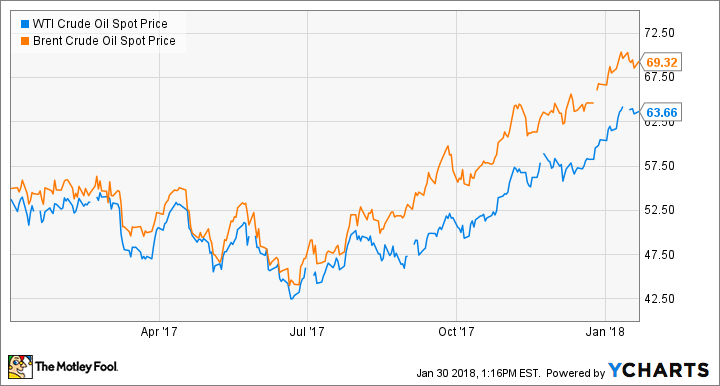Like many who follow and analyze the market, I like turning my analysis of current trends into predictions of what could happen in the future. In each of the past two years, I've outlined some rather bold predictions for the oil market. In both cases, I correctly called one trend, came close on a second call, and totally missed the third. What I learned from that review is that I got the macro trends right and came close to calling the price of oil, but I whiffed on my M&A guess.
That's leading me to refine my approach this year by focusing on the macro and oil price trends that I've been most successful at predicting, and forget about calling the next M&A deal. With that background, here are my three bold predictions for the oil market this year.

Image source: Getty Images.
OPEC gets hooked on higher high oil prices and decides to keep cooperating
In late 2016, OPEC joined forces with several non-member nations in a coordinated effort to reduce their oil supplies by 1.8 million barrels per day for six months starting in January 2017. The partners extended that agreement a few months later and recently agreed to stick with the plan for all of 2018. While it took a while for the strategy to kick in, crude prices have been off to the races in recent months:
WTI Crude Oil Spot Price data by YCharts
With crude rising so sharply, some analysts believe that OPEC might end the agreement early, potentially gradually adding supplies back to the market later this year. But instead of talking about how to exit this deal, recent comments from top oil officials suggest they're thinking about continued cooperation.
"We should not limit our efforts to 2018," top Saudi oil official Khalid al-Falih told reporters earlier in January. "We need to be talking about a longer framework for cooperation." Russia seems to agree that "the world's two biggest oil producing and exporting countries can continue their cooperation for the good of the crude industry, for the good of stability," according to its energy minister, Alexander Novak.
I think that after a few brutal years, OPEC and non-member nations like Russia will want to reap the windfall of higher oil prices for as long as they can, which is why I predict that these groups will extend their cooperation into 2019. While it might not be at the same rate, I don't see them walking away from what's working.
Shale drillers go on a buying binge, but not on what you'd expect
The rapid rise in crude prices over the past few months has been a boon to U.S. shale drillers. Many had already pushed their cost down so they could run well on $50 oil. However, with crude now in the mid-$60s, these companies are beginning to produce a gusher of cash flow.
Many analysts expect them to spend that cash on boosting output even further. However, that doesn't seem to be the plan in most cases. The early indications are that oil companies intend on sticking with their strategy to spend within the cash flow they can generate at around $50 oil this year. That means most will produce a boatload of free cash flow. For example, at $50 a barrel, Anadarko Petroleum (APC) will generate enough cash flow to spend what's necessary to increase its oil production at a 10% to 14% annual clip over the next three years. Meanwhile, at $60 oil, it could achieve that growth rate while generating about $1 billion in free cash flow per year. While Anadarko could plow that cash into more wells, the company seems increasingly likely to return that money to shareholders through a higher dividend and additional stock repurchases.
It's not the only one, since a growing number of U.S. oil companies have decided to return excess cash to shareholders with a buyback. I believe that trend will accelerate in 2018, and I think stronger shale drillers will use the bulk of their oil-fueled windfall to buy back stock.

Image source: Getty Images.
Crude confounds expectations and touches $80 a barrel
Most analysts believe that oil prices have come too far, too fast. The International Energy Agency, for example, doesn't think 2018 will be a happy year for oil prices, expecting crude to dip in the first half of the year. The U.S. Energy Information Administration, meanwhile, forecasts that oil will be in the mid-$50s this year. The driving force behind those predictions is a view that U.S. oil producers will ramp up their drilling efforts and unleash a torrent of production that will push down oil prices.
However, as I noted in my last prediction, I don't think this will happen. As a result, the oil market should remain tightly balanced this year, which should continue nudging crude prices higher until an unexpected supply disruption sends it soaring. While it's anyone's guess which of the many potential disruptions will be the catalyst, I expect that something will drive oil to $80 this year.
Rocket fuel for oil stocks
If I'm right, this year could be an excellent one for oil stocks. That's because my view is that rising oil prices will provide producers with a gusher of cash flow that they'll use to buy back shares. If that happens, it should send their stock prices soaring. That's certainly what has happened with Anadarko since it unveiled its buyback plans in September, with shares up 35% since then, and could happen with peers that follow in its footsteps.






